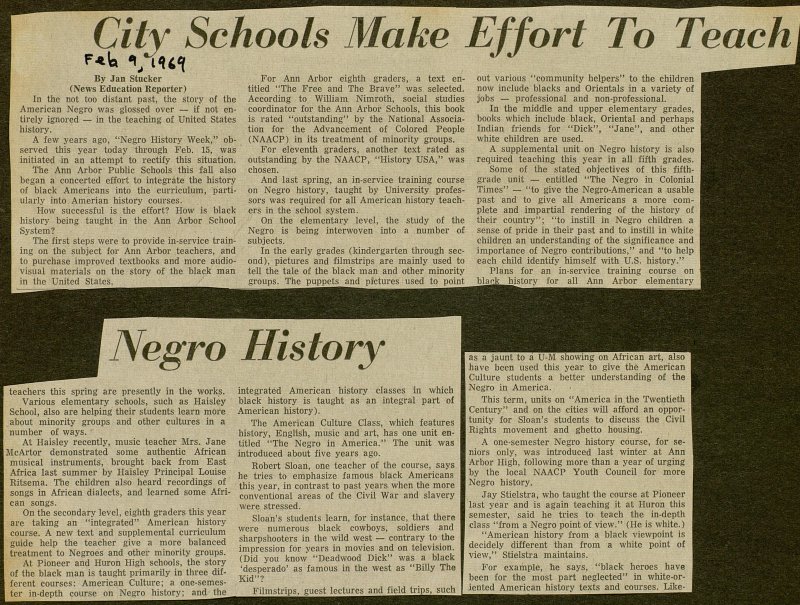City Schools Make Effort To Teach Negro History

In the not too distant past, the story of the American Negro was glossed over - if not entirely ignored - in the teaching of United States history. A few years ago, "Negro History Week," observed this year today through Feb. 15, was initiated in an attempt to rectify this situation. The Ann Arbor Public Schools this fall also began a concerted effort to intégrate the history of black Americans into the curriculum, partiularly into Amerian history courses. How successful is the effort? How is black history being taught in the Ann Arbor School System? The first steps were to provide in-service training on the subject for Ann Arbor teachers, and to purchase improved textbooks and more audiovisual materials on the story of the black man in the United States. For Ann Arbor eighth graders, a text entitled "The Free and The Brave" was selected. According to William Nimroth, social studies coördinator for the Ann Arbor Schools, this book is rated "outstanding" by the National Association for the Advancement of Colored People (NAACP) in its treatment of minority groups. For eleventh graders, another text rated as outstanding by the NAACP, "History USA," was chosen. And last spring, an in-service training course on Negro history, taught by University professors was required for all American history teachers in the school system. On the elementary level, the study of the Negro is being interwoven into a number of subjects. In the early grades (kindergarten through second), pictures and filmstrips are mainly used to teil the tale of the black man and other minority groups. The puppets and pictures used to point out various "community helpers" to the children now include blacks and Orientáis in a variety of jobs - professional and non-professional. In the middle and upper elementary grades, books which include black, Oriental and perhaps Indian friends for "Dick", "Jane", and other white children are used. A supplemental unit on Negro history is also required teaching this year in all fifth grades. Some of the stated objectives of this fifthgrade unit - entitled "The Negro in Colonial Times" - "to give the Negro-American a usable past and to give all Americans a more complete and impartial rendering of the history of their country"; "to instill in Negro children a sense of pride in their past and to instill in white children an understanding of the significance and im.portance of Negro contributions," and "to help each child identify himself with U.S. history." Plans for an in-service training course on blank historv for all Ann Arbor elementary teachers this spring are presently in the works. Various elementary schools, such as Haisley School, also are helping their students learn more about minority groups and other cultures in a number of ways. ' At Haisley recently, music teacher Mrs. Jane McArtor demonstrated some authentic African musical instruments, brought back from East África last summer by Haisley Principal Louise Ritsema. The children also heard recordings of songs in African dialects, and learned some African songs. On the secondary level, eighth graders this year are taking an "integrated" American history course. A new text and supplemental curriculum guide help the teacher give a more balanced treatment to Negroes and other minority groups. At Pioneer and Huron High schools, the story of the black man is taught primarily in three different courses: American Culture; a one-semester in-depth course on Negro history; and the_ integrated American history classes in which black history is taught as an integral part oí American history). The American Culture Class, which features history, English, music and art, has one unit entitled "The Negro in America." The unit was introduced about five years ago. Robert Sloan, one teacher of the course, says he tries to emphasize famous black Americans this year, in contrast to past years when the more conventional areas of the Civil War and slavery were stressed. Sloan's studenls learn, for instance, that there were numerous black cowboys, soldiers and sharpshooters in the wild west - contrary to the impression for years in movies and on televisión. (Did you know "Deadwood Dick" was a black 'desperado' as famous in the west as "Billy The Kid"? Filmstrips, guest lectures and field trips, such as a jaunt to a U-M. showing on Aíncan art, also have been used this year to give thè American Culture students a better understanding of the Negro in America. This term, units on "America in the Twentieth Century" and on the cities will afford an opportunity for Sloan's students to discuss the Civil Rights movement and ghetto housing. A one-semester Negro history cóurse, for seniors only, was introduced last winter at Ann Arbor High, following more than a year of urging by the local NAACP Youth Council for more Negro history. Jay Stielstra, who taught the course at Pioneer last year and is again teaching it at Huron this semester, said he tries to teach the in-depth class "from a Negro pointof view." (He is white.) "American history from a black viewpoint is decidely different than from a white point of view," Stielstra maintains. For example, he says, "black héroes have been for the most part neglected" in white-oriented American history texts and courses.
Article
Subjects
Jan Stucker
University of Michigan
Race Relations
Pioneer High School
Otto W. Haisley School
National Association for the Advancement of Colored People (NAACP)
Huron High School
Education
Ann Arbor Public Schools - Curriculum
Has Photo
Ann Arbor News
Old News
Winona Hall
William Nimroth
Ronald Edmonds
Robert Sloan
Ophelia Brown
Marie Himle
Louise Ritsema
Jay Stielstra
Florence Anthony
Edward Welch Jr.
Chip Holmes
Burel Ford
Arthur Rovner
Arthur Armstrong